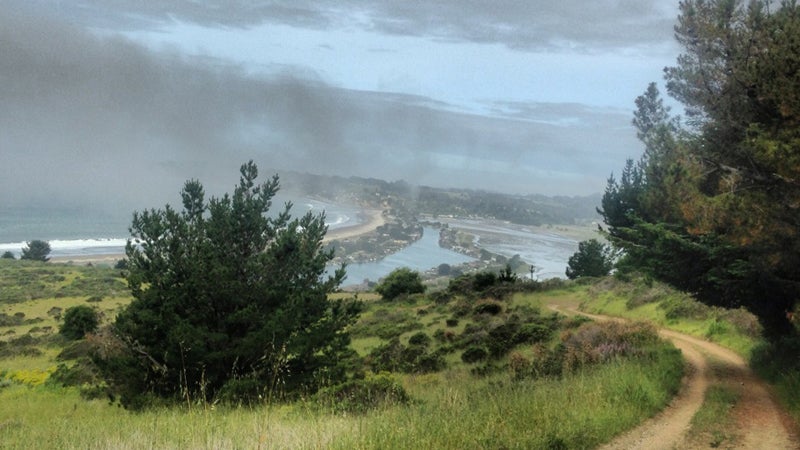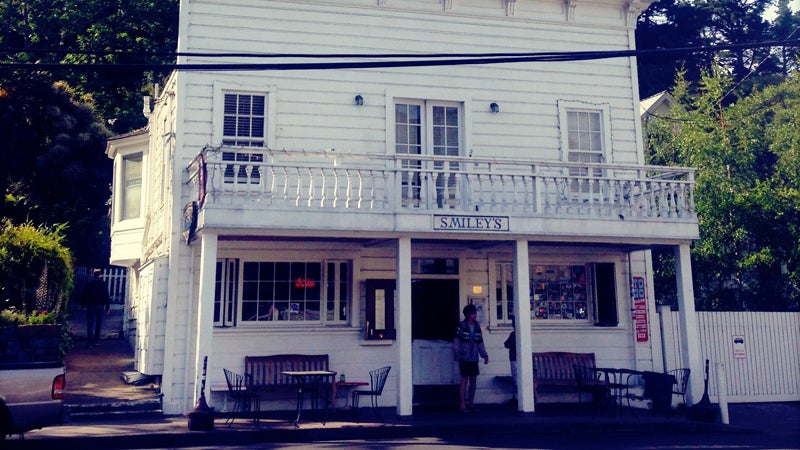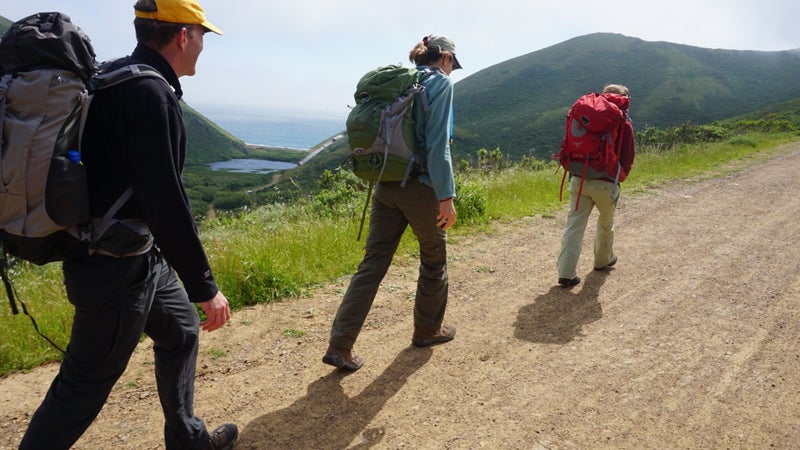Surely one of the most welcome sights after a long day of walking is a whitewashed Tudor inn, tucked back from a small curve of beach, its green lawn scattered with people drinking pints of local beer. Stumble upon this bucolic scene, as we did a couple of weeks ago, and you’d be forgiven for thinking you’re in England. You’re not. You’re actually in northern California, fewer than ten miles from the Golden Gate Bridge.
My sister and her two friends and I arrived at the the old fashioned way: on foot, having trekked seven miles on trails over the steep, breeze-blown Marin Headlands. A celebratory ale was in order, but not before we shrugged off our backpacks and settled into our rooms, small and comfortable, with canopy beds done up in rosy chintz and narrow porches overlooking the crooked peak of Mount Tam.
My pack was so light, I’d almost forgotten I was wearing it. Tight as a drum and remarkably small, it held everything I needed for a four-day trek: light rain jacket and puffy pullover, pair of flip-flops, book and notebook, change of clothes, camera, toothbrush, snacks and water—all of which weighed fewer than 12 pounds.
Of the many marvels of walking along the Marin coast, this was perhaps the greatest revelation. As an ultrarunner, I’m a student in the art of traveling fast and light, but as a parent, I rarely pull it off. I’ve spent the past six years lugging all sorts of extraneous stuff around the country on behalf of two small girls. So to hike for days in lightweight sneakers, without a single pair of socks, was like being reborn. I didn’t have to schlep diapers or a baby med kit or a cavernous six-person tent. Total liberation.
My sister Meg had organized this self-supported hiking trip to celebrate her birthday. Four of us would walk 38 miles from the , just across the Golden Gate Bridge from San Francisco, north to Point Reyes. We’d link together nearly a dozen of west Marin’s most iconic trails—twisting along coastal bluffs and through spring-green meadows ablaze with poppies, and deep stands of redwoods—and three seaside communities: Muir Beach, Stinson Beach, and Bolinas. We wouldn’t camp, but instead stay in small inns and a rental house in the towns along the way. Except for a few miles on pavement, we’d keep to the dirt trails, covering between seven and 14 miles a day.

I couldn’t think of anything I’d rather do more during the first warm days of May than walk with my sister along the Pacific. Walking seemed a hopeful enterprise, an antidote to the pesky on-again, off-again running injuries and persistent self-doubt that have been hounding me for the past four months. The more focused I’ve become on running fast and competing, the less fun I’ve been having and the more my legs hurt. What started as a pure and simple pleasure—running long distances through nature—has begun feeling suspiciously like work. I’m burned out on training, hijacked by ego and expectations, and plagued by a melancholy angst that I’m racing through my daughters’ childhoods.
In other words, I’ve been suffering from a bad case of runner’s block.
What I needed was to get away from running, and thinking about running, for a few days. Of course, being a runner, the last thing I wanted was to actually stop running. I needed the next best thing: I needed to find a new way to cover some ground outside, in nature, on my own two feet that didn’t feel like training. The slower the better.Â
There’s nothing simpler than traveling on foot. You wake up in the morning, eat breakfast, shove what little you brought back into your pack, and head out the door. You walk for a few hours, and stop for a picnic lunch in a meadow overlooking the sea. You’ve packed a turkey sandwich and potato chips and maybe a whoopee pie, and you stretch out in the tall grass for a while. The trail narrows, then widens and narrows again, through tunnels of mossy branches. The fog rolls in and out. You pick a tick off your ankle and step over a garter snake. Sometimes you talk to your companions; sometimes you walk in silence. There is no great urgency to do anything but exactly what you are doing: walking.
Our group of four ranged in experience and speed. My sister’s high school friend Rachel, an avowed urbanite who lives in Brooklyn and works on Wall Street, went to REI three days before the trip and bought one of everything: backpack, hiking boots, zip-off pants, rain jacket. Even trudging up the elevator-shaft uphills out of Tennessee Valley on the first day, she kept a small, game smile on her face and gamely kept up conversation. At the other end of the spectrum, Meg’s boyfriend, Tim, is training for his first marathon. Meg is six feet tall, runs half marathons, and can really bust out a long stride when she feels like it.Â
We didn’t have very far to travel each day, so there was no reason to rush and plenty of incentives to linger. Meg and I stopped frequently to take pictures. Our father was a professional photographer and our entire childhood can be summed up in these words: “One more. OK, just one more.” When he was alive, Dad took pictures constantly, and though we used to roll our eyes in mostly mock annoyance, we’ve turned out just like him. That first night after dinner at the Pelican, Tim confessed, “I knew you two were going to take a lot of pictures, but I wasn’t quite prepared for how many.” We took pictures of the ocean and the Coastal Trail as it wound along Pirate’s Cove and close-ups of poppies and foxglove and slugs and funny signs and pictures of ourselves striking goofy poses and pictures of each other taking pictures.
Thoreau called walking “the enterprise and the adventure of the day,” but compared to today’s crop of extreme sports, walking can seem a little boring. That’s the point! There are few bragging rights and no obvious glory. You don’t have to bravely shoulder enormous packs loaded with camping gear (my streamlined North Face Casmir holds a ruthlessly edited 27 liters of stuff). One of the best things about traveling by foot is that there’s nothing competitive about it. You’re not specifically trying to bag a peak or set a speed record, but simply get from A to B and have a nice time doing it. Moving slowly makes it easier to pay attention, to notice the weird and wonderful you might otherwise whiz by: somebody’s “Happy Good Times” ball cap discarded in the bushes, a distant blurry fox-like animal darting across the trail, random sidewalk shrines. If you can surrender to performing the same simple action over and over—right foot, left foot—day after day, long-distance walking just may be the perfect form of moving meditation.
We kept to a leisurely schedule: long, lazy breakfasts over multiple cups of coffee while reading up on the day’s trails. Meg had gotten the idea from a book, which provided detailed route descriptions. Poring over our maps, we channeled our dad, who’d taught us how to plot routes and read maps during multiday kayaking and cycling trips when we were teenagers. This was our first sister expedition since we’d biked around Prince Edward Island the summer Meg was 17 and I was 15.Â
Some days we traversed single track along high, grassy bluffs, such as the Coastal Trail above Pirate’s Cove and the half-hidden Owl Trail angling north out of Muir, where if you leaned over too far, you felt like you might plunge straight into the sea. But invariably we climbed. “I’ve come to accept that there is no flat ground in northern California,” Rachel announced wryly on the third morning, as we grunted straight up a 1,900-foot slog out of Stinson Beach on the Willow Camp Trail. Had no one ever heard of switchbacks around here?
By three or four each afternoon, we’d emerge from trail into town, blinking a little at the civilization, albeit tiny, that awaited us. After the bucolic scene at Muir Beach, Stinson on a Saturday boomed like a metropolis, but when we arrived in Bolinas on Sunday, it was so sleepy we could walk straight down the middle of the main street without checking for cars. The only hotel in Bolinas is , circa 1851, with a regal-looking false front, a carry-out window, and a few basic motel rooms in the back. We bought a six pack of beer and wandered out to the lagoon to watch the seals and the surfers. It had been our longest day yet—ten miles—and Meg and I were the only ones going on. Rachel and Tim had to get back to work, and Monday would have been our dad’s 77th birthday. We would walk the final 14 miles to Olema, the two of us, for him.Â

In the morning, we caught a ride back out to Highway 1 and walked a mile north past Dogtown to the McCurdy trailhead, where we began a 2,000-foot climb to the . After only four days, our bodies had adjusted to walking uphill under the weight of our packs, and we settled into a comfortable, purposeful pace. Almost too purposeful. Once we gained the ridge, only eight rolling miles through redwoods and blooming cow pasture stood between us and Olema. As the blue of Tomales Bay curved to the north, signaling the start of Point Reyes, Meg’s gait grew longer and I began to dawdle. I didn’t want the freedom of the past four days to end.
All too soon, the trail met the pavement, and we walked the last half mile on the road into Olema. The rental car I’d stashed five days earlier under an enormous, peeling eucalyptus was still there, and Meg and I took the requisite ridiculous shots of each other feigning relief and exhaustion. Dad would have been proud.
The whole drive back to the Headlands, I fantasized about ways to keep going. I could trek out to Point Reyes Seashore or start the whole hike over again from the beginning. For a second, I thought seriously about getting out and running 30 miles of trails back to Meg’s car. When I suggested this out loud, Meg looked at me like I had five heads. Walking slowly hadn’t cured me of wanting to run fast or far, but over four days, it had become for me a kind of minimal, mindful cross-training, a reminder that the best journeys happen when you stop speeding toward the finish line. Now if I can only learn to run the way I walk.
If You Go:
Plan:
Pick up a copy of Tom Courtney’s book, with 12 different trip options, or download the Marin route description at walkaboutcalifornia.com for $7. The 38-mile Marin trek starts at the Marin Headlands Visitor Center and ends in Olema (though you could easily tack on an extra day to explore trails along the Point Reyes National Seashore and overnight in Pt. Reyes Station). The guidebook offers helpful tips about taking public transportation back to your car; we shuttled ours.Â
Stay:
The 16th-century-style in Muir Beach was a trip highlight. The seven guest rooms book well in advance, so reserve yours early; ditto dinner reservations in the candlelit pub. Doubles from $206, including English buffet breakfast. Lodging in Stinson is more spartan: Next door to each other and across Highway 1 from the beach, and have rooms from $125. Both motels were full the weekend we were there, so we rented a house half a block from the beach through . is the only game in Bolinas, unless you rent a house (VRBO and Oceanic Realty have good options); doubles from $114.
Eat:
We had a delicious meal of local, organic lamb, fish stew, and mussels at the Pelican, which reserves its cozy, apres-dinner “snug” behind the pub for guests only; for $12 each, the chef packed sack lunches for us to take on the trail the next day. was the happening spot, with live jazz in the front of the house and plates of local oysters all around. Before we left, we stocked up on sandwiches and empanadas and a homemade whoopee pie at , next to the post office. In Bolinas, the cozy Coast Cafe directly across the street from Smiley’s fed us well with amazingly non-greasy fish and chips and fresh salads. We swigged green smoothies for breakfast at Bobolicious Smoothie Lounge, and pocketed a couple of warm egg sandwiches from the coffee stand across from Smiley’s to take with us for lunch.


